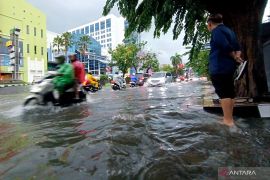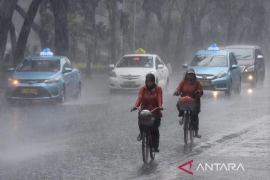Jakarta (ANTARA) - The onset of monsoons in most Indonesian regions in September have also triggered flooding in several provinces, including Jakarta, West Kalimantan, North Kalimantan, West Java, South Sulawesi, Central Sulawesi, West Sulawesi, and West Sumatra.
Indonesia, with monsoon and dry seasons, is prone to natural disasters, and usually some 75 percent of the disasters are hydrometeorological in nature, such as flooding, landslides, and strong winds.
The National Disaster Mitigation Agency (BNPB) reported that during the period from January to Oct 17 this year, Indonesia had recorded 2,276 natural disasters.
The hydrometeorological disasters comprised 827 floods, 637 whirlwinds, and 416 landslides.
The disasters affected 4.5 million people, with 307 individuals losing their lives, 25 persons going missing, and 469 people sustaining injuries. In addition, the disasters caused light, moderate, to serious damage to 35,176 houses and 1,481 public facilities.
The agency also recorded a total of 321 forest and land fires and five volcanic eruptions over the period of time.
In connection with non-natural disasters, chiefly the COVID-19 pandemic, until Oct 23, Indonesia had reported 381,910 confirmed cases, and 13,077 COVID-19 patients had succumbed to the infectious disease.
The Meteorology, Climatology and Geophysics Agency (BMKG) has warned that La Nina natural phenomenon is currently developing until the end of this year, and its impact, notably rainfall, with high precipitation, will peak in January and February and gradually end in March and April 2021.
La Nina, known for causing torrential downpours and widespread flooding across the country, is expected to increase rainfall by nearly 40 percent throughout the country.
The agency projected that 27.5 percent of Indonesia's territory will experience above-normal rainfall at the end of 2020 or during the rainy season. The regions include Lampung, South Sumatra, West Sumatra, parts of Bengkulu, Riau, and parts of North Sumatra and Aceh.
BMKG Head Dwikorita Karnawati noted that during the October-November 2020 period, La Nina would affect nearly all parts of Indonesia.
"What needs to be accorded priority depends on the month since it gets very dynamic from time to time. During the October-November period, this is especially applicable from Java to Nusa Tenggara, Sulawesi, particularly the southern and central parts, Central Kalimantan, and the Maluku Islands and western parts of Papua, including North Maluku," Karnawati noted.
As a precautionary measure against the impacts of La Nina, President Joko Widodo (Jokowi) drew attention to the need for greater awareness of the rising monthly rainfall in Indonesia on Oct 13, 2020.
"The report that I received from BMKG said that the La Nina phenomenon is forecast to cause an increase in the accumulated monthly rainfall in Indonesia by between 20 and 40 percent above the normal rate," the president remarked while chairing a limited cabinet meeting on "Hydrometeorological Disaster Anticipation" held through videoconferencing from the Merdeka Palace in Jakarta.
La Nina is an anomalous condition in the central and eastern parts of the tropics wherein the Pacific Ocean surface temperature goes colder than the normal conditions.
"To this end, I want us all to prepare ourselves as a precautionary measure against the possibilities of a hydrometeorology disaster," he emphasized.
President Jokowi also called to meticulously gauge the impact of La Nina on productions in the agriculture, fisheries, and transportation sectors.
"As 20 to 40 percent is not a small increase, and I also want the information on weather development to be communicated and disseminated as soon as possible to all provinces and regions, so that everyone can know what the future monthly rainfall increase will be like," the president noted.
The agency had earlier stated that the impact of La Nina may not be widespread across Indonesia.
During the period from October to November 2020, an increase in monthly rainfall due to La Nina can occur in nearly all Indonesian regions, except for Sumatra. Furthermore, during the December-February 2021 period, increased rainfall due to La Nina can occur in eastern Kalimantan, Sulawesi, Maluku-North Maluku, and Papua.
In October, several seasonal zones in Indonesia are expected to enter the rainy season, including the east coast of Aceh; parts of Riau, Jambi, South Sumatra, Bangka, Lampung, and Banten; parts of West Java, Central Java, West Kalimantan, and Central Kalimantan; a part of East Java; South Kalimantan; part of East Kalimantan; part of North Kalimantan; a part of Sulawesi; North Maluku; and a small part of West Nusa Tenggara.
There are rising concerns that the increase in rainfall will lead to landslides and floods, so all related parties are necessitated to immediately take mitigatory measures to reduce the disaster risk to ensure no resulting casualties.
The BNPB had earlier appealed that all stakeholders, including the public, should utilize meteorological data as a precautionary measure against the impacts of La Nina, so that disaster mitigation can be conducted carefully.
While addressing a webinar themed "La Nina Phenomenon. What should be done?" on Oct 11, BNPB Deputy for Prevention Lilik Kurniawan stated that the BMKG had supplied various weather forecast data accessible to the public.
The BNPB also has the InaRisk application that maps disasters in various regions in Indonesia.
The government and public can use existing data in planning various measures, so that La Nina, which is in sight, would not cause major losses, both material and non-material.
La Nina-induced natural disasters could be damaging, so the authorities should ensure the durability of various public facilities. Furthermore, the central and local governments should take precautionary measures to prioritize food security, since natural disasters, including flooding, can affect farming areas.
Hence, the Social Affairs Ministry has readied nearly 39 thousand volunteers as a precautionary measure against the impact of La Nina.
"The Social Affairs Ministry ensures that logistical assistance is always ready. The president's instruction is clear that we must distribute the assistance in the event of a natural disaster. To this end, we have readied almost 39 thousand volunteers," Social Affairs Minister Juliari Batubara had stated recently.
The volunteers remain on high vigil despite no disaster. As such, if a disaster occurs, the ministry will promptly instruct volunteers to distribute assistance and conduct other activities in the affected areas.
As the COVID-19 pandemic continues unabated, the ministry will gauge the condition of affected areas to determine the technique of evacuating disaster victims, he stated.
Tents to shelter disaster victims will be set up in accordance with the health protocols, including restricting the number of evacuees in each tent, he remarked.
In September, Dr Indra Permanajati of the General Soedirman University (Unsoed) had reminded of the importance of preparing mitigatory measures and raising awareness of hydrometeorological disasters during the transition from dry to rainy season.
"People must be aware of hydrometeorological disasters during the transitional season, especially those living in disaster-prone locations," Permanajati noted in Purwokerto, Banyumas District, Central Java Province.
The coordinator of geological disasters at the Mitigation Center of Jenderal Soedirman University explained that hydrometeorological disasters are those influenced by water-related fluctuations, including rainfall.
Permanajati believed that disasters, including floods, landslides, and strong winds, could be affected by changing seasons.
Hence, he highlighted the need for the community to increase awareness in the event of moderate- to high-intensity rainfall for a long duration.
"Information on disaster preparedness and disaster mitigation efforts must continue to be disseminated to the entire community," he emphasized.
The member of the Indonesian Association of Disaster Experts also noted that disseminating information on the importance of mitigation efforts to reduce the impact of disaster risks should be intensified to build awareness and increase community preparedness for possible disasters.
Being ravaged by natural disasters amid the ongoing COVID-19 pandemic would deal a dual blow to the nation. Hence, early preparations to mitigate the impacts of the catastrophe are crucial. (*)










